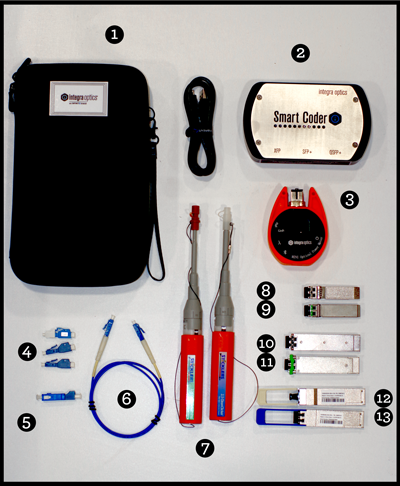 Perfecting the everyday carry is a finish line that’s always moving. Network engineers and administrators need an emergency kit that they can rely on to address emergencies, and have on hand at all times. Often times when an emergency happens, the engineer on the site realizes what they had on hand just wasn’t enough. When creating a kit, it is important to think about the best set of tools and spares that has the most versatility and that enables the network engineer to address the most emergency scenarios without taking up the space of a refrigerator. Also, keep in mind that what you need to address a service impacting outage is about what is immediate, where as a scheduled maintenance is restoring the network to its optimal configuration and parts.
Perfecting the everyday carry is a finish line that’s always moving. Network engineers and administrators need an emergency kit that they can rely on to address emergencies, and have on hand at all times. Often times when an emergency happens, the engineer on the site realizes what they had on hand just wasn’t enough. When creating a kit, it is important to think about the best set of tools and spares that has the most versatility and that enables the network engineer to address the most emergency scenarios without taking up the space of a refrigerator. Also, keep in mind that what you need to address a service impacting outage is about what is immediate, where as a scheduled maintenance is restoring the network to its optimal configuration and parts.

Integra’s Essential Every Day Carry:
- 1. It all starts with a case. There comes a time when you realize the supplies that are floating around your laptop bag or backpack might not be the most reliable and you start to get organized. Picking something that’s compact, and water and dust resistant is a start. You probably won’t stick with one case forever so generally sizing to what you anticipate on carrying and revising later is best.
- 2. Components that enable other items to do more. Carrying an Integra Optics Smart Coder, Smart Coder+, or Smart Coder2 allows you to make the most of the transceivers you choose to carry. It gives you the ability to code to different platforms, change the wavelength on tunable transceivers, and view digital diagnostics and monitoring information on transceivers that support DDM.
- 3. Do we have light? Having a good light meter with you is always handy. Usually, you don’t need something that’s laboratory reference grade but a good all-around one can take a licking and has good battery life is a trusty companion. This will allow you to verify the presence of light, identify what wavelengths are present, and determine if the power levels are where you expect them to be.
- 4. Attenuating for versatility. You can’t use a transceiver designed for a 10km span to go 80km, but if you have the right attenuators you can use an 80km optic to go 10km. The receivers have an overload threshold that if exceeded can temporarily blind them or permanently damage them. Having just a few attenuators will allow you to use long distance optics for long medium or short hauls. And being so compact, they won’t be a carry burden. Carrying a 5dB, 7dB and 10dB is a great start.
- 5. Adaptability. If your network is anything other than a brand-new build, you probably have more than one type of fiber connector present. LC is the most common for transceivers, but power meters and patch panels can use another connector formats a well, like SC. Something to convert between connectors, like this LC to SC adapter, is going to buy you quite a bit of convenience and function.
- 6. BYO jumper. Ideally, each facility location will have a small library of the jumpers used there. Even so, having a 1-meter jumper to use for looping up transceivers (with appropriate attenuators mentioned above) or for taking light readings (using the LC to SC adapter we just noted) can make diagnosing issues easier and faster. With the amount of space this will take, it’s definitely a good addition.
- 7. Cleaning up. A top cause of transceiver and infrastructure problems is contamination. With two cleaning wands you can clean 125um and 250um jumpers, transceivers, bulkheads, adapters, and attenuators. These Clean Clickers do a great job getting fiber endfaces clean to avoid or resolve issues.
- 8. Local traffic SFP+. For LAN issues over a multimode fiber infrastructure, we suggest the 1568-IO. It gets up 10G ethernet or up to 16G fiber channel at up to 100 meters. Code it with the Smart Coder and go.
- 9. SFP+ for singlemode fiber. When picking the single transceiver that can save the day in the most cases, the 80km tunable SFP+ 1560-IO is incredible. With attenuation you can use it for shorter spans, you can tune it to communicate over passive DWDM filters, and its wideband receiver can link with many greywave transceivers too. With the Smart Coder it’s got unbeatable versatility for addressing outages.
- 10. & 11. XFPs are still around. The XFP versions of 8 & 9 are the 24CE-IO and 24C6-IO. LAN and WAN diagnostics and restoration sometimes requires preparing for different transceiver formats.
- 12. & 13. 100G links. The 5B7D-IO is a QSFP28 SR4 with support for 100G and 112G OTU4 rates over MPO terminated 8 or 12 lane multimode jumpers at distances up to 100 meters. The 5B73-IO is a QSFP28 LR4 that also does 100G or 112G OTU4 rates, but this one runs over a duplex singlemode pair at distances up to 10km. The selection of the right transceivers for you comes down to looking at what’s present in your network and determining what parts make sense to have on hand. If you are trusting any links with 100G traffic, you definitely need a disaster plan for the event of an interruption.
Who doesn’t want to be a hero? With a carefully chosen kit, you’ll save the day. Contact one of our optics experts to customize your perfect emergency tool kit!
PR Archives: Latest, By Company, By Date